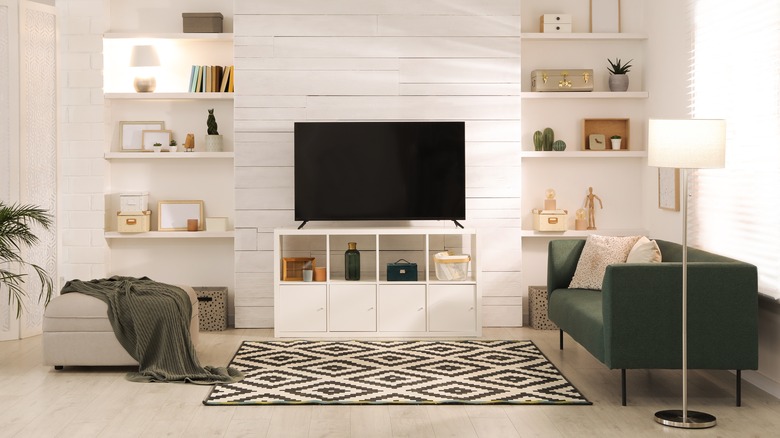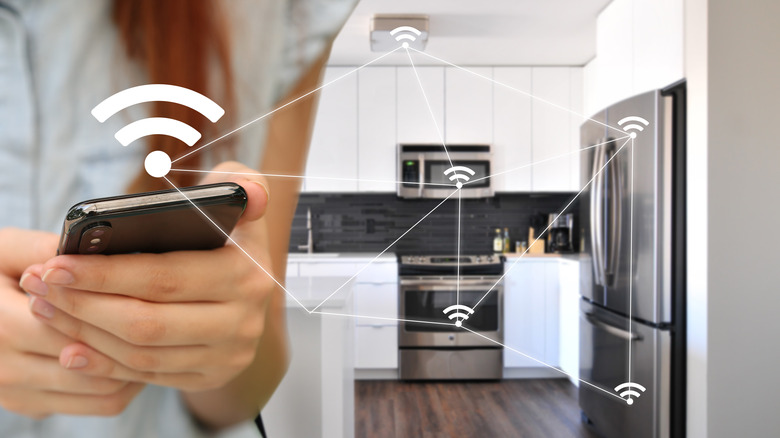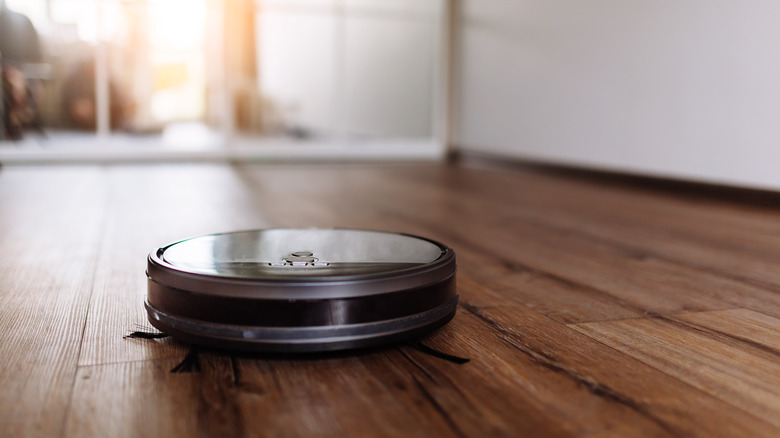The 1967 Program That Eerily Predicted Many Facets Of Modern Life
Welcome to ... the future! A land of flying cars and hovering cities, inflatable Thanksgiving dinners that expand to size with a single drop of water, an abundance of luxury and ease, weekend trips to the moon, and a civil society of peace, love, and beauty. See? Science fiction really can be the same thing as fantasy.
From "The Jetsons" to "The Matrix," "Star Trek" to "Dune," "The Terminator" to "The Last of Us," it's clear that humanity is more than a bit obsessed with its own fate. Are such preoccupations fueled by a fear of death and a sense of our own cosmic irrelevance? Or — as is seeming more and more unlikely in modernity — are such preoccupations fueled by excitement, hope, and wonder about the progress of technology and the human spirit?
Back in the 1960s such questions took on a different, almost innocent tenor. Many aspects of our present would have been nearly impossible to foresee, particularly sociopolitical movements. Technological developments, though? They're a bit easier to predict. In a 1964 BBC Horizon documentary, sci-fi author Arthur C. Clarke described the 21st-century internet and its impact on the workplace and society with disturbing accuracy. About three years later esteemed news anchor Walter Cronkite began hosting a three-year-long, 15-episode TV series called "The 21st Century." In it, as Smithsonian Magazine says, Cronkite described the early 21st century as a land of videophones, robo-servants, 3D-printed per-meal crockery, homes powered by individual fuel cells, and much more.
A spot-on living room prediction
Unfortunately, as the Australian Centre for the Moving Image (ACMI) says, the Walter Cronkite-hosted "The 21st Century" (1967 to '69) has not been digitized and is not available to view in full online. We've only got snippets and bits here and there on YouTube and a couple of whole episodes. That being said, we've got enough information to know that some of the predictions made on the show were shockingly spot-on. Others were completely wrong and even a bit bizarre.
The living room of the future, though? "The 21st Century" got that very right. 3D TV? Check — although the 3D part still comes from glasses. Surround sound? Check. The speakers look like the light-bulb trooper helmets from "Spaceballs," but whatever. A unified entertainment system that connects various media and switches between TV and music? Check. Central air-like environmental control for the entire house? Not super common, but yes, check. Windows that tint to darken or lighten the room? Okay, not yet — not until they're easier to implement than plain old curtains or blinds.
Most pointedly, "The 21st Century" predicted a console-like control panel for the living room with all sorts of buttons, knobs, and switches. In the Cronkite-hosted show, this panel looks copy-pasted from the bridge of the Enterprise on the original "Star Trek." We now know that a keyboard works better, with all those buttons and switches being digital and screen-based. But still, analog does have a certain charm.
A totally wacky and unbelievable kitchen
In this article's opening set of unrealistic future home predictions, we mentioned Thanksgiving dinner expanding to size from a single drop of water. Shows like "The Jetsons" famously featured robotic arms and tubes sprouting from the wall to aid in various cooking or cleaning ventures. Other centuries-distant visions of the future — to reference "Star Trek" again — feature replicators that materialize matter into any combination of food items in response to voice command. The kitchen portrayed in "The 21st Century" might not be nearly as advanced as this, but it's still way, way ahead of reality and extremely generous in its estimations.
On the show, industrial designer Henry Dreyfuss correctly said that folks in the future would cook less at home and rely more on food bought from stores, especially fully prepared meals. He also correctly said that some folks would still prefer cooking, and that microwaves would be widespread. Beyond those basics, things get wacky — "The 21st Century" predicted food packs with built-in power sockets to plug in and self-heat and edible packaging that dissolves into the meal rather than producing tons of horrible plastic pollution. It also predicted fully on-demand "programmed" meals ordered via a "punched computer card" that automatically fetches ready-made items from the cupboard, passes them to a conveyor belt in a see-through box that cooks the food en route, and then slides it out of a door on a plate ready to eat.
An extremely accurate home office
The home office is where "The 21st Century" gets eerily accurate. Maybe it wasn't too hard to imagine the kind of home office demanded of folks in the future. Maybe the things needed by future home offices were common sense enough to predict given then-current technological trends. "The 21st Century" didn't quite reach prophetic levels of accuracy — some of the things predicted were vaguely retro and along the lines of "future newspaper delivery" — but it got darn close.
Smithsonian Magazine lays out the home office described in "The 21st Century." At the heart of it is the centerpiece of any modern office: a personal computer. The show doesn't call it a desktop, laptop, or anything but a "computerized communications console." The show essentially describes a worldwide network of information sharing that connects all such consoles and says that the console's screen "provides a summary of news relayed by satellite from all over the world." You can also save personal copies of information to your own console. The console also serves as a telephone with a little mouthpiece/speaker combo to communicate with others around the house. To this point host Walter Cronkite describes an honest-to-goodness closed-circuit camera system that allows someone to view each part of the house on little screens on the console. The show even mentions, without really going into details, an "electronic correspondence machine" that could stand in for any number of modern communication devices like smartphones.
Robotic servants galore
Much like many past visions of the future, "The 21st Century" predicted a future society flush with robot butlers, robot maids, robot cleaners, robot helpers — basically a legion of robot servants zipping around each and every household. Think of R2D2 in "Return of the Jedi" on Jabba the Hutt's sand hovercraft thing rolling around and serving drinks if you'd like. "Robots are coming. Not to rule the world, but to help around the house," Smithsonian Magazine quotes Walter Cronkite, continuing, "We may wake up each morning to the patter of little feet — robot feet." But judging by the perplexed and/or dubious frown on Cronkite's face as he watches one robotic helper whir and clunk its way toward him, he wasn't necessarily a believer.
As Professor M.W. Thring explains on the show, such robots were "the first prototypes of small-scale models of the domestic housemaid of the future" designed to do things "the housewife" finds dull. Okay, so the show wasn't totally forward-thinking in every way. Professor Thring does, however, say that robotic servants can accept instructions that modify their programming and behavior, such as don't "run over the baby." He also says that robots need not look human. While "The 21st Century" got the physical presence of robots in the house mostly dead wrong (rhumbas don't count), it did correctly predict a facet of robotics far more important than mechanical physicality: artificial intelligence (AI).
Flying cars? Still not quite
And so we come to what everyone's been waiting for and has groused about for decades: cars of the future. As "The 20th Century" opens in its final 1969 episode, "The beauty, speed, and efficiency of the modern automobile exemplify the energy of 20th-century America — its energy and its problems." The episode goes on to show cars crashing and skidding out, and even more depressing, shows pictures of vast concrete hellscapes of car-centric cities consumed by roads and parking lots. Against this backdrop the episode proceeds to discuss a host of common-sense automobile developments that will improve the health and safety of future drivers and a couple of oddball changes that never happened.
The list of improvements that "The 20th Century" got right about future cars is honestly impressive: "inflated pillows" (airbags), a "computer-controlled braking system" (anti-lock brakes), highway signs that dislodge at the bottom when struck rather than crush cars like a tree, cruise control, electronic sensors that check the distance between cars, and more. Things that the show didn't quite get right include an emotional-response mechanism that checks the driver's heart rate and stress level through gold-plated conductors on the steering wheel and then reports its findings to the driver (the technology is similar to that of a lie detector). Unfortunately for us, but fortunate for the episode's modest, practical predictions, there's not a flying car to be seen anywhere.





